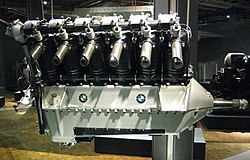This article includes a list of references, related reading, or external links, but its sources remain unclear because it lacks inline citations .(April 2018) |
| BMW VI | |
|---|---|
 BMW VI at the Technik-Museum Berlin | |
| Type | V engine |
| Manufacturer | BMW |
| First run | 1926 |
| Major applications | |
| Developed from | BMW IV |
| Developed into | |
The BMW VI was a water-cooled V-12 aircraft engine built in Germany in the 1920s. It was one of the most important German aero engines in the years leading up to World War II, with thousands built. It was further developed as the BMW VII and BMW IX, although these saw considerably less use. It was also produced in the Soviet Union as the M-17 and Japan as the Kawasaki Ha-9.



